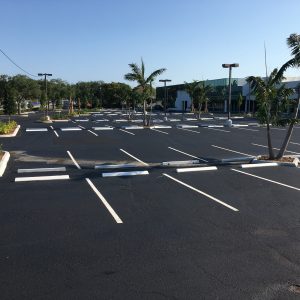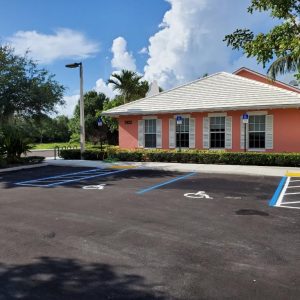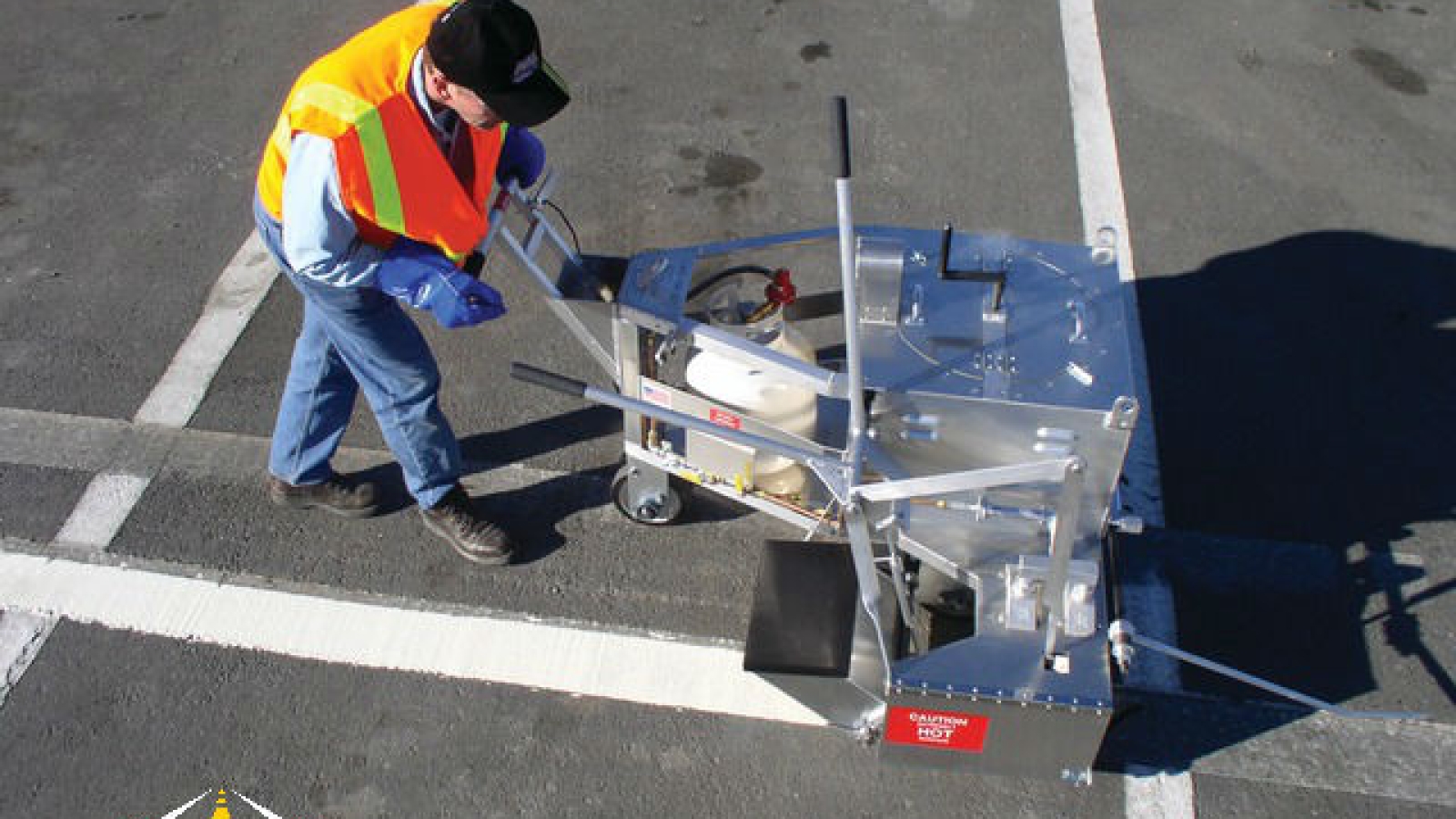WHAT IS THERMOPLASTIC PAINT?
Thermoplastic paint is a 100% solid compound conformed by the mix of certain different elements such as glass beads, binders, pigments and fillers, that becomes liquid when heated. This type of service is often used for parking lots and traffic marking paint. There are three types of resin such as hydrocarbon (an oil based resin), alkyd (based on natural wood resin derived), and a modified alkyd called acrylic.
This material is used for road and parking lot striping as well as for pavement markings. Additionally, it’s properties bring security to both the environment and the personnel in charge of handling it.
Each material that composes this type of mix adds a unique and specific characteristic to the final result. The pigments, for example, add color and opacity; glass beads bring retroreflectivity that make it easier for people to see markings at night. Meanwhile, binder adds toughness, flexibility and bond strength maintaining those components together; and, last but not least, fillers give volume to the mixture.
HOW IS THERMOPLASTIC PAINT APPLIED IN PARKING LOTS / ROAD PAVEMENT MARKINGS?
For the thermoplastic mixture to have a good and efficient performance, those elements must be heated to the proper temperature. The melting point ranges between 400 F to 440 F; and has to be constantly stirred up in order to make those elements dissolve completely and become an homogeneous mixture ready to be poured on the desired surface.
Thanks to the temperature that the mix is subjected to, when poured on the concrete surface this liquid mixture will melt and will produce a thermal bonding layer. In case there are porous areas, the poured material will start to fill those holes, creating a mechanical block on top making it much easier to adhere.
In order for the marking material to achieve an excellent bond with the concrete pavement, it is necessary to preserve the inside heat during the entire process.

It is ideal for the material to hold a thickness of 90 mils, in order to preserve the internal heat. Following this ensures the material a long term life, besides, durability and retroreflectivity along this period. Finally, if it is necessary to fix an old string on the pavement, the thickness of the new layer is about 30 mils in order to keep the internal warmth.
At the beginning of the process, pavement must be completely dry because depending on moisture level the thermoplastic paint will adhere properly to the pavement surface. There are several ways to test the internal moisture in order to know when to begin the work.
It is not recommended to carry out this type of work early in the morning since fog and dew may generate moisture conditions on the pavement surface creating some type of blisters on the thermoplastic striping applied thanks to its several temperature variations during the process.
 When pouring the previously prepared mixture for the thermoplastic, it is recommended to pour it at minimum 50F. Handling the material at low temperatures may cause it to not adhere well on the surface and the operation must be stopped immediately.
When pouring the previously prepared mixture for the thermoplastic, it is recommended to pour it at minimum 50F. Handling the material at low temperatures may cause it to not adhere well on the surface and the operation must be stopped immediately.
This temperature must be reached at the point where the heated mixture and the road surface meets. In the process, when pouring the thermoplastic pavement marking, the glass beads must be replicated by a mechanic and immediately on the specific area. The material muy adhere right away, if this result is not observed, the operation must be stopped until heat mixture and the surface temperature.
3 TYPES OF PROCESSES TO PERFORM THERMOPLASTIC MARKINGS
In order to perform a thermoplastic marking, there are 3 different types of procedures which are:
- Extrude: For this type of thermoplastic application, the equipment must keep a constant and low speed, always with the sprinkler in direct contact with the work area.
- Ribbon: The equipment uses a ribbon gun in this type of thermoplastic application. Unlike the previous procedure, this ribbon gun does not have to be in direct contact with the ground, which allows the procedure to be performed much faster; the gun must be raised from 1 to 1.5 inches from the surface.
- Spray: This service can also be applied with a spray sprinkler. These sprinklers use atomized air to spread the thermoplastic material. As the ribbon gun application type, this procedure may be performed quickly as the spray needs to be from 4 to 5 inches from the floor, it is even faster than with the ribbon gun one.
SAFETY RECOMMENDATIONS
The main risk factor in the thermoplastic marking process is the high temperatures that the materials and operations are exposed to, which is why it is necessary to take mandatory precautions with every employee, such as using the proper clothing in order to avoid any type of accident, some of these elements are protection glasses, thermo protective gloves and covers for exposed skin. In addition, special care needs to be taken with nearby properties due to the high temperature used.
Finally, it is recommended to start heating the equipment 2 hours before starting working on the thermoplastic pavement. While the material internal temperature is decreasing, the mixture must still be agitated in order to not let each element place at the bottom of the kettle.
Parking Lot Striping near me? Call us today at 1-888-439-7623 to work with a professional asphalt contractor, we guarantee excellent customer service.

